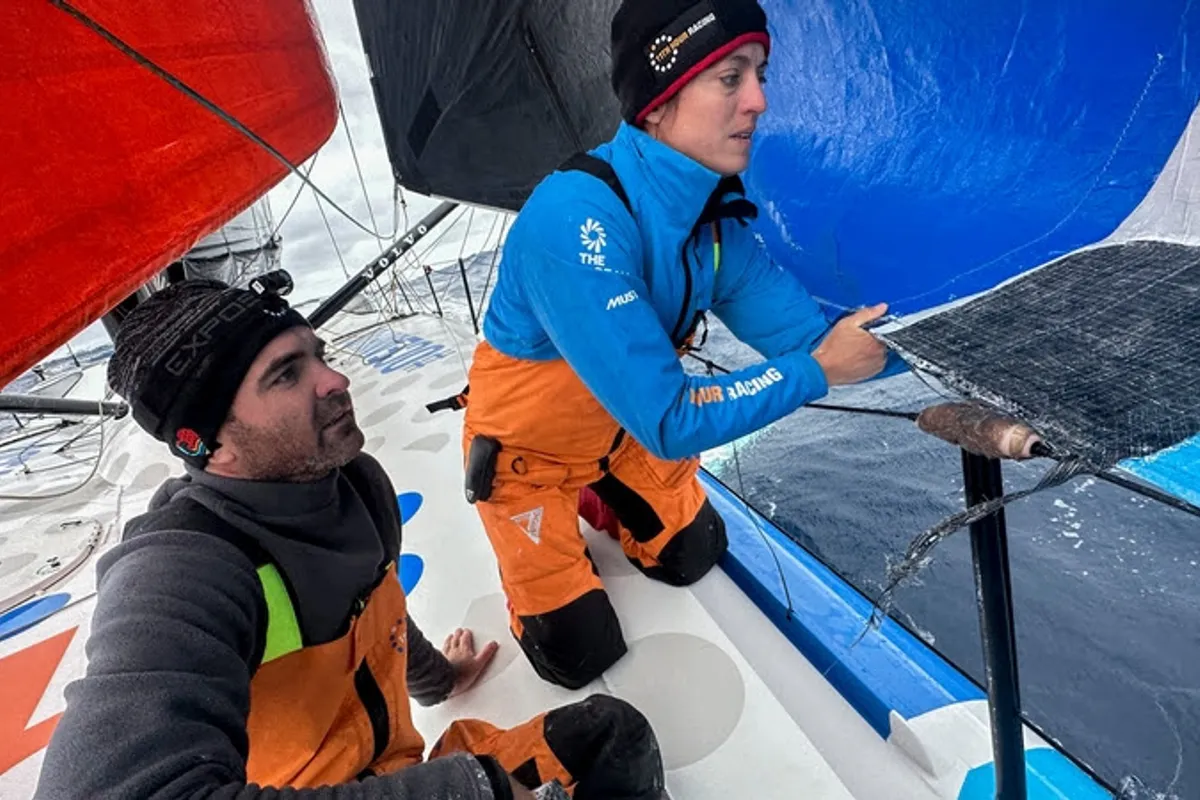Transitional weather marks opportunity for gains and losses
It's an interesting day in The Ocean Race with quick moving weather making for a day of transitions in the southern latitudes.
The big winner over the past 24 hours is second placed Biotherm, who have gained over 30 miles on Team Holcim-PRB.
At the other end of the spectrum, 11th Hour Racing Team appear to be in danger of dropping off the back of a weather system and are making a noticeable dive to the south, toward the southern edge of the race course defined by the ice exclusion zone.
A reduced sail wardrobe due to ongoing repairs has meant the team has struggled to hold on to the chasing pack and stay in the same weather system.
According to the latest weather routing, the ETA at the first scoring gate is nearly a week away on 13 March. Incredibly, the routing shows compression in the fleet, with the teams arriving much closer together than they are today.
Benjamin Dutreux's GUYOT environnement - Team Europe have confirmed they will pull out of Leg 3 and focus on making repairs to their boat to be ready to rejoin the race in Itajaí, Brazil.
From the team:
"The decision has been made. We had no choice. If we had resumed the third leg and sailed around the Southern Ocean to Itajaí, we would not have had time to prepare for the next leg. We would then have always been late on the other legs as well. In Itajaí, we still have 60 percent of the race to go. We lose 20 percent now, but then we will be ready for the remaining 60 percent," explained skipper Benjamin Dutreux.
After the NDT (non-destructive testing) of the yacht, no further damage was found apart from the delaminated area on the port side of the hull in the cabin area, but the repair will still take some time. The current weather in Cape Town with wind and rain is not playing into the team's cards. In order to be able to carry out the work, the yacht was placed on the cradles between the two team containers. Sheets were used to create a working area that was as protected from the rain as possible.
Before the delaminated area can be opened from the outside, the tech team around Thomas Cardrin reinforced the inner area with carbon laminate. On Wednesday, the outer carbon layer of the hull will be cut open and the Nomex core removed. The inner carbon layer will remain. The honeycomb structure will be replaced by a foam sandwich core, which will be glued in place on Thursday. GUYOT environnement - Team Europe received great help from Team Holcim - PRB in procuring the foam board and carbon fibres, as the special materials required were not readily available in South Africa.
After gluing in the sandwich foam, the open area will be laminated again with carbon fibres on Friday morning. Filling, sanding and lacquering work should complete the process by Sunday, before the yacht is likely to be back in the water on Tuesday next week.
"Meanwhile, the sailing team is preparing for the transfer and the next stages. We can't intervene with the repairs, we have four experienced boat builders for that," says Dutreux. In addition, a specialist from Holcim is assisting with the work. "We are now planning the delivery and the next legs. The transfer to Itajaí will be made by part of the sailing crew and the technical team."
Thomas Cardrin, head of the tech team at GUYOT environnement - Team Europe, expects the yacht to be back to 100 per cent load after the repairs.
Image: Onboard 11th Hour Racing Team. Justine Metttraux and Charlie Enright checking on the J2 repair and stanchion upgrade while on the bow.
© The Ocean Race Amory Ross / 11th Hour Racing / The Ocean Race
About The Ocean Race
Since 1973, The Ocean Race has provided the ultimate test of a team and a human adventure like no other. For nearly 50 years, it has kept an almost mythical hold over some of the greatest sailors and been the proving ground for the legends of our sport.
The 14th edition of The Ocean Race started from Alicante, Spain on 15 January 2023, and will finish in Genova, Italy early in the summer of 2023. The race visits nine iconic cities around the globe over a six-month period (Alicante, Spain - Cabo Verde - Cape Town, South Africa - Itajaí, Brazil - Newport, RI, USA - Aarhus, Denmark - Kiel Fly-By, Germany - The Hague, the Netherlands - Genova, Italy) and features a leg with the longest racing distance in the 50-year history of the event - a 12,750 nautical mile, one-month marathon from Cape Town, South Africa to Itajaí, Brazil. The IMOCA fleet of mixed crews will pass all three great southern Capes - Cape of Good Hope, Cape Leeuwin, Cape Horn - non-stop, for the first time.
Along with five confirmed foiling IMOCA teams racing around the world, six one-design VO65 boats will race on three legs with an option to compete for a new trophy within The Ocean Race called The Ocean Race VO65 Sprint Cup.
